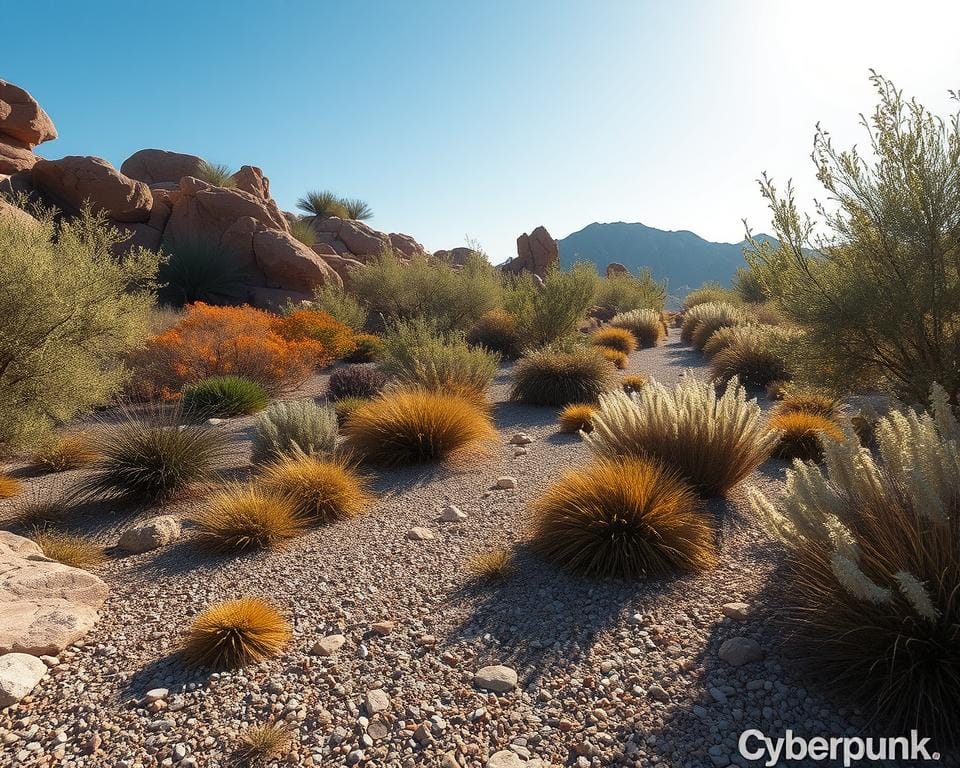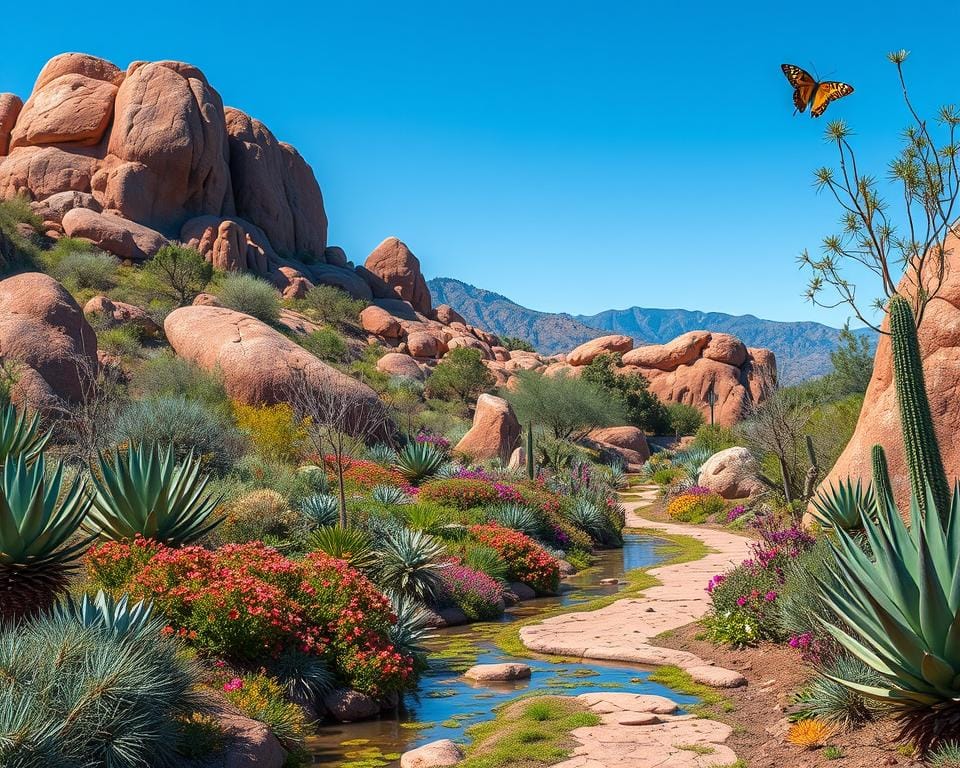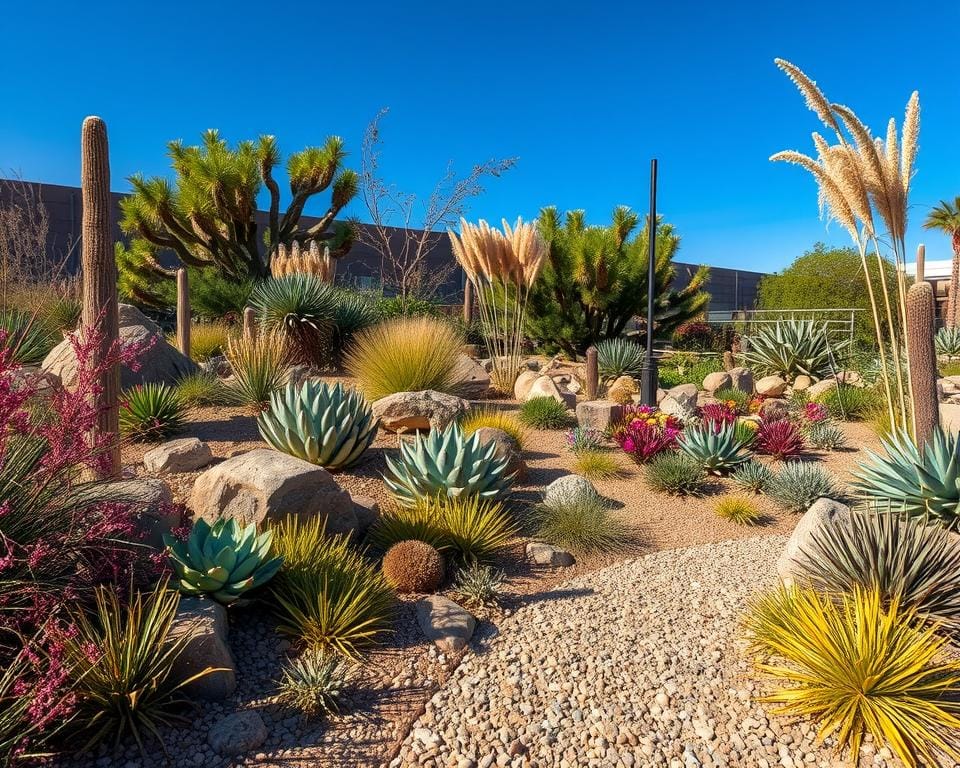Xeriscaping is a smart landscaping method that cuts down on water use. It’s ideal for those wanting water-efficient gardens, especially in dry areas like Denver, Colorado. Due to frequent droughts, many have adopted xeriscaping to save water.
At its heart, xeriscaping means choosing plants that need little water. It also involves using alternatives to grassy lawns, like soil, rocks, and mulch. This approach not only saves water but also makes gardens easy to care for and beautiful, even in dry conditions.
In Novato, California, a study showed households saving 120 gallons of water each day with xeriscaping. They used efficient watering systems and plants that suit the local weather. This cut water use by 50 to 75 percent, proving that xeriscaping works well for water conservation.
Xeriscaping also saves money. Gardens designed this way use less water, which means lower water bills. They are also easier and cheaper to maintain, cutting down on costs for fertilizing and lawn care.
Experts say xeriscaping is good for the environment and local wildlife. Using native plants helps the local ecosystem and supports animals like pollinators. Techniques like mulching improve soil and stop erosion, helping the planet too.
For more info on creating water-efficient gardens, check out Aquasana. It offers tips and tools to bring xeriscaping to life. This way, you can have a beautiful garden that needs less water and is easier to keep up.
What is Xeriscaping?
Xeriscaping is a landscaping method that saves water. It uses plants that don’t need much water and smart watering ways. The idea comes from “xeros” for dry, and “scape” for view. It’s great for places where water is scarce, making gardens both pretty and eco-friendly.

Definition and Origin
Xeriscaping started in Tucson, Arizona, because of the need for more water. It’s not about using no water, but using it smartly. This approach can cut water use by up to 75% compared to regular lawns. In cities, xeriscaping can save 30–50% of water in parks and save about $2 million a year.
Seven Principles of Xeriscaping
There are seven key ideas behind xeriscaping. They help make gardens that need little water and are good for the planet:
- Planning and design: Good planning means plants and water systems are put in the best spots.
- Soil improvement: Adding compost improves soil, which helps plants and saves water.
- Practical turf areas: Having less grass means using less water.
- Efficient irrigation: Using drip irrigation or soaker hoses saves a lot of water.
- Mulch use: Mulch keeps moisture in, keeps soil temperature stable, and stops weeds.
- Selection of low water-use plants: Picking plants like Little Bluestem grass or Appalachian Sedge is smart. They need less water and care.
- Appropriate maintenance: Checking plants and soil moisture keeps your garden healthy and strong.
Using xeriscaping ideas means less water use and more beautiful gardens. And, these gardens are good for our ecosystems.
Environmental Benefits of Xeriscaping
Xeriscaping is great for the environment and perfect for eco-friendly landscaping. It uses plants that don’t need much water, saving a lot of it. On top of saving water, it helps local wildlife and keeps gardens biodiverse.

Water Conservation
Water saving is a big win with xeriscaping. By choosing plants that thrive with less water, we don’t need to irrigate them much. Xeriscaped spots can use up to 75% less water than regular gardens. Also, smart watering gadgets like the OtO device make saving water even easier by watering plants just the right amount.
Supporting Local Wildlife
Xeriscaping is a friend to local animals too. When we use plants native to the area, we create homes for birds, butterflies, and more. This helps keep the balance of nature. These plants are meant to be there, so they let local animals thrive.
Reducing Soil Erosion
Soil erosion is a big problem, but xeriscaping can help. Using things like mulch and rocks helps keep the soil right where it should be. These materials also keep the soil healthy, moist, and less weedy. So, we get a beautiful garden without harming the earth or needing harsh chemicals.
| Environmental Benefit | Description |
|---|---|
| Water Conservation | Reduces water consumption by up to 50-75%, lowers water bills by up to 80% |
| Local Wildlife Support | Utilizes native plants to attract and support local fauna |
| Soil Erosion Reduction | Uses mulch and organic materials to conserve soil and prevent erosion |
Financial Savings with Xeriscaping
Xeriscaping your yard not only helps the planet but also cuts down your costs. One main way it saves money is by using less water. Homeowners who switch to xeriscaping can see their water bills drop a lot. For example, people in Novato, California, saved 120 gallons of water every day.
Xeriscaping is also cheap to maintain because it uses plants that don’t need much water. You won’t have to spend time and money on watering, fertilizing, or cutting the grass often. In dry places like Denver, Colorado, and Phoenix, Arizona, xeriscaping makes even more sense. It’s a smart way to cut costs and save water.
Xeriscaping saves money by requiring fewer resources. Using local plants, stones, and mulch means you don’t need expensive non-local plants or big watering systems. In Novato, California, making yards more xeriscape-friendly dramatically lowered water and upkeep costs. The design focuses on efficient watering, so every drop goes right to the plants, reducing waste.
Starting a xeriscape project can cost between $15,120 and $18,400, averaging around $17,000. But, these costs are quickly made up by what you save over time. In Flagstaff, AZ, for example, homeowners save about 8,000 gallons of water each year. That’s a savings of $275 annually. Plus, xeriscaping can cut your water bill by up to 80% and lower lawn care costs by 87%.
Besides saving money, xeriscaping can increase your home’s value by about 14%. It reduces the need for fossil fuels and harmful fertilizers, cutting down on energy use and pollution. So, choosing to xeriscape means you’re making a smart, cost-effective decision. This approach offers a great look, significant financial savings, and helps the environment.
Effective Techniques for Xeriscaping Water Use
Using water-efficient methods is key in xeriscaping. It lowers water use more than regular gardening does. With smart watering and better soil, we can have lush gardens that don’t need much water.
Efficient Irrigation Systems
For saving water, using efficient irrigation is top-notch. Devices like the OtO monitor weather and plants to water just right. They put the right amount of water exactly where needed, cutting down on waste.
Drip irrigation and soaker hoses are also good. They help plants grow deep roots and survive dry times. In places like Florida, using these smart methods can cut water use by up to 75%.
Learn more about water-saving technologies.
Use of Mulch and Soil Improvement
Mulch and better soil are important, too. Organic mulch keeps soil moist and gets better as it breaks down. It helps keep water in the soil and plants happy.
Improving soil with organic stuff helps it hold more water. This makes gardens healthier and helps the planet. It means our gardens need less water and give more back.
| Technique | Benefit |
|---|---|
| Smart Irrigation | Optimizes water use by analyzing weather and plant data |
| Drip Irrigation | Promotes deep root growth and reduces evaporation |
| Organic Mulch | Retains moisture, reduces evaporation, and enhances soil fertility |
| Soil Improvement | Enhances water retention and provides essential nutrients |
Combining smart watering with mulch and better soil can save lots of water. It helps us keep our gardens beautiful without wasting water. We help save a vital resource and enjoy green spaces.
Choosing the Right Plants
Starting a xeriscaping project means picking the right plants is key. Picking drought-resistant greenery and plants that do well in deserts lets your garden succeed without using much water. This not only makes your garden more sustainable but also boosts its beauty and strength.
Drought-Tolerant Plants
Drought-tolerant plants are made for dry environments. These include succulents, herbs like lavender, rosemary, and sage, and perennials such as yarrow and Russian sage. They have deep roots and thick leaves to keep water in and reduce water loss. Ornamental grasses, like Blue Fescue and Purple Fountain Grass, bring beauty and interest with little water needed.
Native Plants
Choosing native plants adds another level of sustainability. They’re already used to the local weather and soil, so they need less water, fertilizer, and care. Native plants like California Poppy, Blackfoot Daisy, and Desert Marigold save water and help local animals by providing food and homes. They make your xeriscape garden lively and eco-friendly.
Examples of Xerophytes
Xerophytes are the best for saving water – these plants are super good at living in very dry places. They include cacti like the famous saguaro, agave, and the ocotillo. These plants are built for tough conditions and save water in their thick parts. Using xerophytes can greatly reduce or even remove the need for extra watering, which is what water saving is all about.
In the driest areas, 60% of a home’s water use can be outside. By choosing the right plants, we can use much less water. If you want more tips on making your garden water-wise, here’s a great guide to read.

